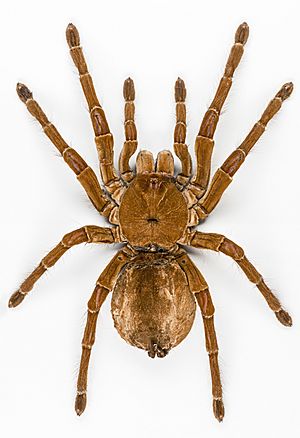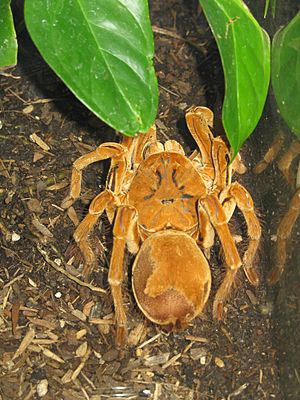Goliath birdeater spider facts for kids
Quick facts for kids Goliath birdeater |
|
|---|---|
 |
|
| Scientific classification | |
| Synonyms | |
|
The Goliath birdeater (Theraphosa blondi) is a giant spider. It is part of the tarantula family. This amazing creature lives in northern South America. It is the heaviest spider in the world, weighing up to 175 grams (about 6 ounces). It can also be very long, up to 13 centimeters (5 inches) in body length. Only the giant huntsman spider has a wider leg span. People also call it the Goliath bird-eating spider. Explorers gave it this name after seeing one eating a hummingbird. But don't worry, it almost never eats birds!
Contents
What Does the Goliath Birdeater Look Like?
The Goliath birdeater is truly huge! Its legs can spread out up to 30 centimeters (12 inches) wide. Its body can be as long as 13 centimeters (5 inches). These spiders can weigh as much as 175 grams (6 ounces). They are usually tan or light brown. They often have a golden shine. Their bodies, bellies, and legs are covered in hair.
Life Cycle of the Goliath Birdeater
Female Goliath birdeaters do not eat the males after mating. This is different from some other spider species. Females grow up in 3 to 6 years. They can live for a long time, usually 15 to 25 years. Males do not live as long. They die soon after they become adults, living only 3 to 6 years.
A female spider lays many eggs, usually 100 to 200. These eggs hatch into tiny spiderlings in about 6 to 8 weeks.
How Goliath Birdeaters Behave
Defenses of the Goliath Birdeater
When a Goliath birdeater feels threatened, it has special ways to protect itself. It can make a loud hissing sound. It does this by rubbing special hairs on its legs and mouthparts together. This sound is called stridulation.
The spider can also rub its belly with its back legs. This releases tiny hairs into the air. These hairs can cause a lot of itching and irritation if they get on skin or in eyes.
Like all tarantulas, the Goliath birdeater has large fangs. These fangs can be 2 to 4 centimeters (1 to 1.5 inches) long. They are big enough to break human skin. These spiders carry venom in their fangs. They might bite if they feel in danger. However, their venom is not very harmful to humans. Its effects are similar to a wasp sting. Tarantulas usually only bite people to defend themselves. Sometimes, they even give a "dry bite" with no venom.
What Goliath Birdeaters Eat
Even though it's called the "birdeater," this spider rarely eats birds. In the wild, it mostly eats other large arthropods. These include insects and other spiders. It also eats worms and amphibians like frogs.
Because of its large size, it can also catch and eat small animals. These include different kinds of insects. It also eats small animals that live on the ground. When it catches prey, it doesn't eat it out in the open. Instead, it drags its meal back to its burrow. There, it turns the insides of its prey into liquid. Then, it sucks the liquid dry. Wild Goliath birdeaters have been seen eating rodents, frogs, toads, lizards, and even small snakes.
Where Goliath Birdeaters Live
The Goliath birdeater lives in the rain forests of northern South America. You can find them in Suriname, Guyana, French Guiana, northern Brazil, and southern Venezuela. They are most common in the Amazon rainforest. These spiders live on the ground in deep burrows. They are often found in wet or marshy areas. They are active at night.
Goliath Birdeater as Food
The Goliath birdeater is an edible spider. Some people in northeastern South America eat this spider. They prepare it by burning off its irritating hairs. Then, they roast it in banana leaves. People say it tastes like shrimp!
See also
- Giant huntsman spider, the spider with the largest leg span in the world
- Mongolarachne jurassica, the largest known spider from fossils
- Cerbalus aravaensis, a huntsman spider found in Israel and Jordan



